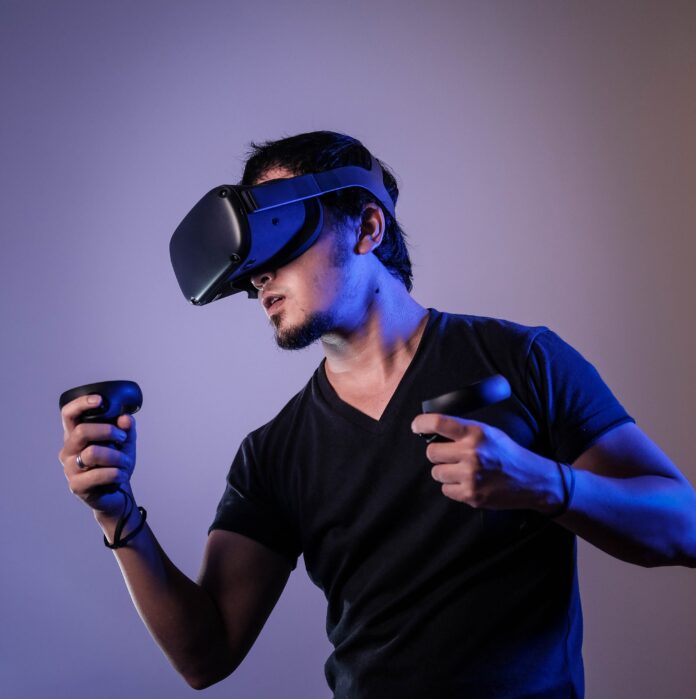Virtual Reality (VR) is an immersive technology that has gained significant attention and popularity in recent years. It is a computer-generated simulation of a three-dimensional environment that can be interacted with and explored by a user. Through the use of VR headsets and other input devices, individuals can experience a sense of presence and immersion in a virtual world. The concept of VR has been around for several decades, but recent advancements in technology have made it more accessible and realistic than ever before.
In the realm of Virtual Reality, users are transported to a simulated environment that can be either entirely fictional or a replication of the real world. This virtual environment is typically presented to the user through a head-mounted display (HMD) that covers their field of vision, creating a visual experience that mimics being physically present in the virtual world. The HMD tracks the user’s head movements and adjusts the displayed imagery accordingly, enhancing the feeling of immersion and presence.
One of the key components of VR is the ability to interact with the virtual environment. This is achieved through various input devices, such as hand controllers or motion-tracking systems. These devices allow users to manipulate virtual objects, navigate through the virtual world, and engage with the surroundings. The sensation of touch and haptic feedback can also be incorporated into VR experiences through the use of specialized gloves or suits, further enhancing the sense of realism and immersion.
The applications of Virtual Reality are wide-ranging and continue to expand across various industries. In the field of entertainment, VR offers a new level of engagement and immersion in gaming experiences. Players can step into the shoes of a character, explore fantastical worlds, and interact with virtual objects in ways that were previously unimaginable. VR has the potential to revolutionize the gaming industry, providing a more immersive and captivating form of entertainment.
Beyond entertainment, Virtual Reality has found applications in fields such as education and training. In educational settings, VR can create immersive learning environments that allow students to explore historical sites, travel through space, or dive into the depths of the ocean, all from the confines of a classroom. This technology enables experiential learning and can greatly enhance the retention and understanding of complex subjects.
In the realm of training and simulation, VR has proven to be a valuable tool. Industries such as aviation, medicine, and military training have embraced VR as a means to provide realistic and safe training environments. Pilots can practice flying in various weather conditions without the risks associated with real-world training. Surgeons can rehearse complex procedures before entering the operating room. Soldiers can undergo tactical training in virtual battlefields. VR allows for repetitive practice, scenario customization, and immediate feedback, all of which contribute to more effective training outcomes.
Another area where Virtual Reality is making significant strides is in the field of healthcare. VR has shown promise in pain management, rehabilitation, and mental health therapy. By immersing patients in virtual environments that are designed to distract or relax them, VR can help alleviate pain and reduce anxiety during medical procedures. In rehabilitation settings, VR can assist patients in regaining motor skills and improving coordination through interactive exercises. For individuals suffering from mental health conditions such as phobias or post-traumatic stress disorder (PTSD), VR-based therapies offer a safe and controlled environment for exposure therapy and emotional regulation.
Virtual Reality also has the potential to transform the way we communicate and collaborate. With the advent of social VR platforms, users can meet and interact with others in virtual spaces, regardless of physical location. This opens up possibilities for remote work, virtual meetings, and virtual events. Collaborative VR environments enable teams to work together on projects, visualize data in three dimensions, and manipulate virtual objects in real-time, enhancing productivity and fostering creativity.
As Virtual Reality continues to advance, there are still challenges and considerations that need to be addressed. One such challenge is the issue of motion sickness or cybersickness, which some users may experience due to a disconnect between their visual and physical sensations. Efforts are being made to minimize these discomforts through improved hardware and software optimizations. Another consideration is the accessibility of VR technology, as cost and technical requirements may limit its widespread adoption.
Furthermore, the future of Virtual Reality looks promising as ongoing research and development are focused on addressing the current limitations and expanding the capabilities of this technology. Advancements in display resolution, field of view, and tracking accuracy are continuously improving the visual quality and realism of VR experiences. Additionally, the development of more compact and comfortable headsets aims to enhance user comfort and reduce the barriers to adoption.
One area of innovation in VR is the incorporation of augmented reality (AR) elements. Augmented Reality overlays virtual content onto the real world, while Virtual Reality creates a fully immersive virtual environment. Combining these two technologies, known as Mixed Reality (MR), can offer users a blend of real-world and virtual elements, creating even more interactive and engaging experiences. This integration opens up possibilities for applications in areas such as architecture, interior design, and product visualization.
The content available for Virtual Reality is also expanding rapidly. Game developers, filmmakers, and content creators are embracing VR as a new medium for storytelling and entertainment. Virtual reality games are becoming more sophisticated, providing deeper narratives, realistic graphics, and immersive gameplay. Additionally, VR movies and interactive experiences are captivating audiences by transporting them into the heart of the story, allowing them to explore and engage with the narrative in a whole new way.
The business potential of Virtual Reality is also gaining attention. Companies are exploring the use of VR for marketing, product demonstrations, and virtual showrooms. With VR, customers can visualize products in a realistic environment, try out virtual prototypes, and make informed purchasing decisions. The architecture and real estate industries are utilizing VR to showcase designs and provide virtual property tours, saving time and resources while offering clients an immersive experience.
However, despite its rapid growth and potential, Virtual Reality still faces some challenges. The cost of high-quality VR equipment can be a barrier for many consumers, limiting its mainstream adoption. Additionally, the creation of high-quality VR content requires significant resources and expertise, which may hinder the availability of diverse and compelling experiences. As technology advances and becomes more affordable, these challenges are expected to be addressed, allowing VR to reach a wider audience and become an integral part of our daily lives.
In conclusion, Virtual Reality is a groundbreaking technology that offers immersive and interactive experiences across various domains. From entertainment and education to healthcare and communication, the potential applications of VR are vast. As technology continues to evolve and accessibility improves, Virtual Reality is poised to reshape industries, enhance human experiences, and unlock new opportunities for innovation and creativity. Whether it’s diving into virtual worlds, training in realistic simulations, or collaborating in virtual spaces, Virtual Reality has the power to transform the way we perceive and interact with the world around us.














